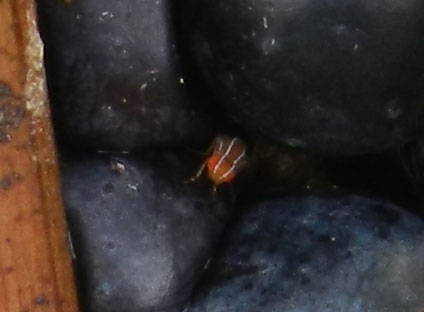

II. Hosts: This fly is capable of developing in multiple crops, but may not be able to penetrate uninjured fruit as does spotted wing drosophila. However, AFF may outnumber SWD when adults emerge from grapes.
III.
Description: This fly is brown
in color, with longitudinal white body stripes, thinly
bordered by black. See adult flies in dorsal
and oblique
view.
The eggs bear resiratory horns, as do other drosophilid
eggs. However, a genus characteristic of Zaprionus is
that the egg has four respiratory horns.
IV. Biology: This species apparently cannot overwinter in Virginia and must recolonize the state from more southern regions each year. Aspects of its biology in Virginia are still under investigation. In these video clips made by Jamie Wahls (Dept of Entomology, Virginia Tech), an adult can be see forcing its way out of the puparium (note the ptinilum (front part of the face) expanded to force open the puparium), and once emerged, expanding its wings.
V. Injury: African fig fly
develops in a variety of fruits, introducing Candida yeast,
which acts to speed breakdown of the fruit.
In Brazil, there have been economic infestations in
fig, persimmon and a local fruiting tree species, Solanum
lycocarpum.
VI. Monitoring: Monitoring
methods are under investigation. While adults appear in
apple cider vinegar traps placed for SWD, these may not be the
most effective means of sampling for FFF. Some earlier
publications use fermenting banana baits.
VII. Control: Controls,
if needed, will probably be similar to those developed for SWD.
VIII.
Additional reading:
Pfeiffer,
D. G., M. E. Shrader, J. C. E. Wahls, B.
N. Willbrand, I. Sandum, K. van der Linde, C.
A. Laub, R. S. Mays, E. R. Day. 2019. African fig fly
(Diptera: Drosophilidae): Biology, expansion of geographic
range and its potential status as a soft fruit pest. J. Integr. Pest
Manag. 10(1): 1-8. https://doi.org/10.1093/jipm/pmz018
Ramniwas, S., B. Kajla and R. Parkash. 2012. Extreme physiological tolerance leads the wide distribution of Zaprionus indianus (Diptera: Drosophilidae) in temperate world. Acta Entomol. Sin. 55: 1295-1305.
Shrader,
M.
E.*, H.J. Burrack and D. G. Pfeiffer. 2019. Effects of
interspecific larval competition on developmental parameters
in nutrient sources between Drosophila suzukii
(Matsumura) (Diptera: Drosophilidae) and Zaprionus indianus
Gupta. J. Econ. Entomol. Advance: 1-9 (https://doi.org/10.1093/jee/toz297)
van der Linde, K. 2010. Zaprionus
indianus: Species identification and taxonomic
position. Dros. Inf. Serv. 93: 95-98.
van der Linde, K. 2012. Zaprionus
indianus distribution in the United States. Retrieved
25 Nov 2012, from
http://www.kimvdlinde.com/professional/Zaprionus%20distribution%20US.php.